
For Florida homeowners juggling numerous responsibilities, replacing every window with hurricane-resistant ones isn’t always reasonable or possible – or even necessary. What’s crucial is understanding the essential upgrades to safeguard your home from potential damage. In this article, we’ll explore the signs of compromised and weakening windows that may be a risk factor to your home under the pressure of a storm:
- Drafts and Air Leaks: Do you feel chilly drafts near your windows during winter or notice a blast of heat in the summer? These are signs that your window seals have deteriorated, making them less energy-efficient. Addressing drafty windows can not only improve your comfort but also reduce your energy bills year-round.
- Condensation Between Panes: Have you noticed fogging or condensation forming between the panes of your double or triple-pane windows? This indicates a seal failure and reduces your window’s ability to insulate your home effectively. Ignoring condensation issues can lead to further damage to your windows and even potential mold growth within your home.
- Visible Damage to the Window: Take a closer look at your window frames and glass. Do you see cracks, chips, or warping? These are clear indicators that your windows need replacing, especially since damaged windows are more likely to fail during a storm.
- Difficulty Operating: Are your windows a pain to open or close? Do they struggle to lock properly? Not only is this inconvenient, but it also compromises your home’s security and can be a serious issue during severe weather. If a window has warped to the point where you can visibly see and experience damage to its structure, the internal structural integrity is almost certainly compromised.
- Increased Noise: Have you noticed an uptick in outside noise seeping into your home? This could mean that your window’s insulation capabilities have diminished over time. This type of inconvenience may seem minor or trivial on a day-to-day basis, but it’s what it implies that’s the problem when it comes to structural integrity. If sound can easily seep through, what else is getting in?
- Water Damage or Rot: Check around your window frames for any signs of water damage like stains, soft wood, or mold. If you spot any, it’s a clear sign that your window isn’t sealing out moisture properly. Addressing water damage promptly is crucial to prevent further structural issues and maintain your home’s integrity – in or out of hurricane season.
Evaluating Which Windows to Replace
While it might be ideal to replace all the windows in your home simultaneously, this isn’t always necessary or feasible. Window replacement doesn’t have to be an all-or-nothing job. Now that we’ve identified some signs that it might be time to replace your windows, let’s talk about how to prioritize.
- Prioritize by Condition: Start by replacing the windows that show the most significant signs of wear and damage such as buckling seals, gaps, or warping wood. These windows are the most vulnerable during a storm.
- Exposure to Elements: Consider replacing windows that face the direction from which storms typically approach (for example, the side of the house facing prevailing winds). These windows are more likely to be subjected to high winds and flying debris.
- Age of Windows: If your windows are over 15-20 years old, it may be more cost-effective and safer in the long run to replace them, as modern windows offer better technology and materials for storm resistance.
- Professional Inspection: Have a professional window installer or home inspector evaluate your windows. They can provide a detailed assessment of the windows’ condition and recommend whether repair or replacement is necessary.
Creating a Plan of Action
By addressing the most vulnerable windows first and ensuring all windows are properly maintained and sealed, you can significantly enhance your home’s resilience against storms. Upgrading to hurricane replacement windows one or some at a time can be a better alternative than taking no action until you feel ready to complete the entire project.
When cost is a barrier, there are programs in Florida in place to help homeowners make critical storm safety upgrades. Florida’s PACE program works to give homeowners the funds to make significant upgrades with no upfront costs. The first step is to find out if you qualify. As an approved PACE program contractor and a specialist in hurricane preparedness home upgrades, our team at Infinity Windows and Doors is dedicated to helping you navigate the process of qualifying for the program.





Leave a Reply